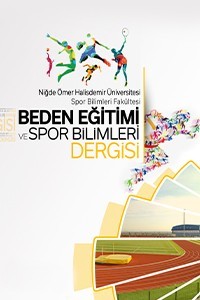ÇOCUKLARA UYGULANAN FARKLI OTUR-UZAN ESNEKLİK TESTLERİNİN KARŞILAŞTIRILMASI
Çocuk, Esneklik, Esneklik Testleri, Fiziksel Uygunluk
COMPARISION OF DIFFERENT SIT AND REACH TESTS IN CHILDREN
Children, Flexibility, Flexibility Tests, Physical Fitness,
___
- American College of Sports Medicine. ACSM’s guidelines for exercise testing and prescription, lippincott williams&wilkins,2000; Sixth Edition
- Balcı Ş.S., Tamer K., 1.-5. Sınıf ilköğretim öğrencilerine yönelik fiziksel uygunluk test bataryası, Selçuk Üniversitesi Eğitim Fakültesi Dergisi, 2005; Sayı 20:329-349
- Baltacı G., Un N., Tunay V., Besler A., Gerçeker S., Comparison of three different sit and reach tests for measurement of hamstring flexibility in female university students, Br J Sports Med, 2003;37(1): 56-59.
- Docherty D., Measurement in Pediatric Exercise Science, Human Kinetics, USA,1996.
- Freedson P.S., Cureton K.J., Heath G.W., Status of field-based fitness testing in children and youth, Preventive Medicine,2000;31:77-85
- Gutin B., Manos T., Strong W., Defining health and fitness: First step toward establishing children’s fitness standarts, Research Quaterly for Exercise and Sport,1992; 63 (2): 128-132.
- Güler D., 8-10 Yaş grubu erkek çocuklarda AAHPERD fiziksel uygunluk test bataryasının sosyo-ekonomik düzey ile ilişkilendirilmesi, Gazi Üniversitesi Sağlık Bilimleri Enstitüsü, Yayınlanmamış Doktora Tezi, 2003.
- Heyward V.H., Advanced Fitness assessment and Exercise Prescription, Fiffth Edition,Human Kinetics, USA, 2006;1-425.
- Hui SS-C, Yuen PY., Validity of the modified back-server sit and reach test: a comparison with other protocols, Medicine and Science in Sport and Exercise,2000;Vol. 32, No.9:1655-1659.
- Jackson A., Langford N.J., The Criterion-Related Validity of the Sit and Reach Test: Replication and Extension of Previous Findings, Research Quarterly for Exercise and Sport, 1989: 60, No. 4, pp.384-387.
- Jackson A.W., Baker A.A., The Reliationship of the Sit and Reach Test to Criterion Measures of Hamstring and Back Flexibility in Young Females, Research Quarterly for Exercise and Sport, 1986: Vol. 57, No. 3, pp.183-186.
- Lemmink K.A.P.M., Kemper H.C.G., de Greef M.H.G., Rispens P., Stevens M., The Validity of the Sit-and-Reach Test and the Modified Sit-and-Reach Test in Middle- Aged to Older Men and Woman, Research Quarterly for Exercise and Sport, 2003:Vol. 74, No.3, pp.331-336.
- Looney M.A., Plowman S.A., Passing rates of american children and youth on the FITNESSGRAM criterion-referenced physical fitness standards, Research Quarterly for Exercise and Sport,1990; 61(3): 215-223.
- Lopez-Miñarro P.A., Andşjar P.S.B.,Rodríguez-García P.L., Comparison of the sit- and-reach test and the back-saver sit-and-reach test in university students Journal of Sports Science and Medicine (2009) 8, 116 - 122
- Malina R.M, Bouchard C., Growth, maturation and physical activity, Human Kinetics Boks,1991.
- Martin S.B., Jackson A.W., Morrow Jr. J.R., Liemohn W.P., The Rationale for the Sit and Reach Test Revisited, Measurement in Physical Education and Exercise Science, 1998:2(2), 85-92.
- Özer S., Özer K., Çocuklarda motor gelişim, Nobel Yayınları, Baskı-4,Ankara, 2005,177, 182-183.
- Pate RR., Health fitness, “physical education and sport for the secondary school student” Edited by Dougherty NJ et al., Sponsored by NASPE an association of AAHPERD,1983.
- Patterson P., Wiksten D.L., Ray L., Flanders C., Sanphy D., The Validity and reliability of the back saver sit-and-reach test in middle school girls and boys, Research Quarterly for Exercise and Sport,1996; Vol. 67, No.4:448-451.
- Pekel H.A., Balcı Ş.S., Arslan Ö., Bağcı E., Aydos L., Tamer K., Pepe H., Kalemoğlu Y., Atletizm yapan çocukların performansla ilgili fiziksel uygunluk test sonuçlarının ve bazı antrepometrik özelliklerinin değerlendirilmesi, Kastamonu Eğitim Dergisi, 2007;15 (1): 427-438.
- President’s Council on Physical Fitness and Sport (PCPFS), Current ıssues in flexibility fitness, Research Digest,2000; Series 3, No 10;1-6
- Tamer K., Sporda Fiziksel-Fizyolojik Performansın Ölçülmesi ve Değerlendirilmesi, 2. Baskı, Bağırgan Yayımevi, Ankara, 2000.
- Tekelioğlu A., Devlet Okulu ve Özel Okullarda Okuyan 11–13 Yaş Grubu Kız ve Erkek Çocukların Fiziksel Uygunlukları, Doktora Tezi, Gazi Üniversitesi, Sağlık Bilimleri Enstitüsü,1999.
- Zorba E., Fiziksel Uygunluk,Gazi Kitabevi,ikinci baskı, Muğla,2001;148,278,277
- ISSN: 1307-6477
- Yayın Aralığı: Yılda 3 Sayı
- Başlangıç: 2007
- Yayıncı: Niğde Ömer Halisdemir Üniversitesi
ÇOCUKLARA UYGULANAN FARKLI OTUR-UZAN ESNEKLİK TESTLERİNİN KARŞILAŞTIRILMASI
İlter ŞAHİNER, Şükrü Serdar BALCI
SEKTÖR KAVRAMLARI İÇERİSİNDE BULUNAN SPOR SPONSORLUGUNA BİR BAKIŞ
Tamer KARADEMİR, Sebahattin DEVECİOĞLU, Murat ÖZMADEN
Hüseyin KIRIMOĞLU, Yunus YILDIRIM, Ali TEMİZ
Hakan Salim ÇAĞLAYAN, Bekir MEHTAP
SPOR TATMİNİNİN SPORCULARIN STRES VE SALDIRGANLIK DÜZEYLERİ ÜZERİNDEKİ ETKİSİ
